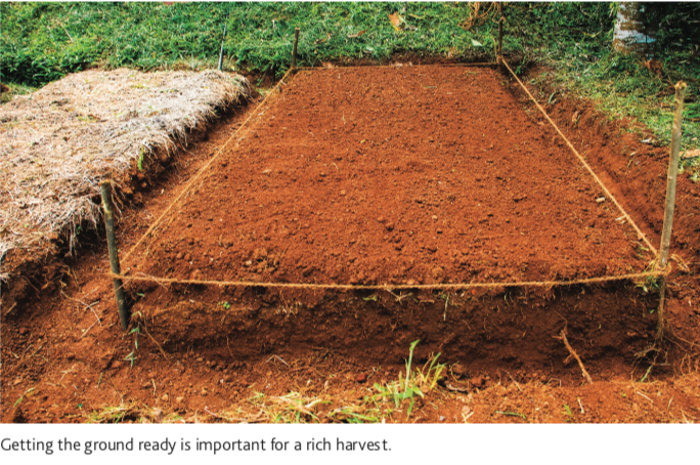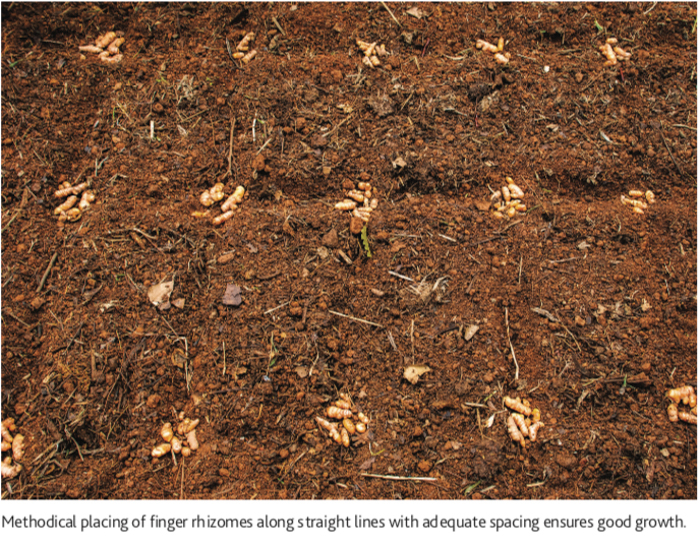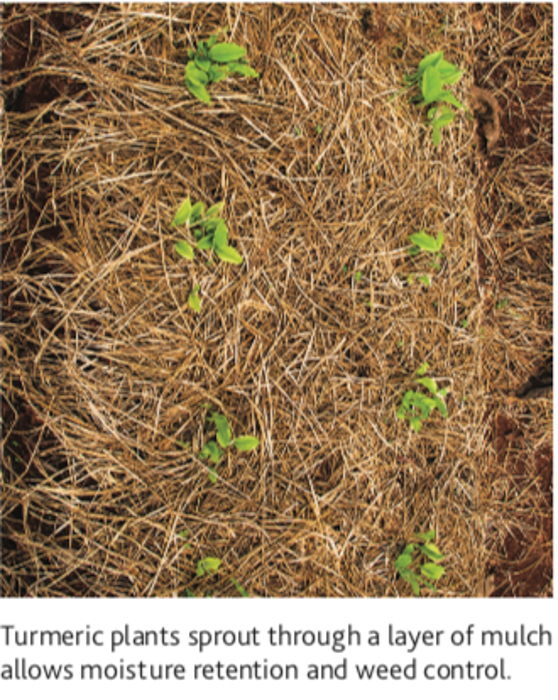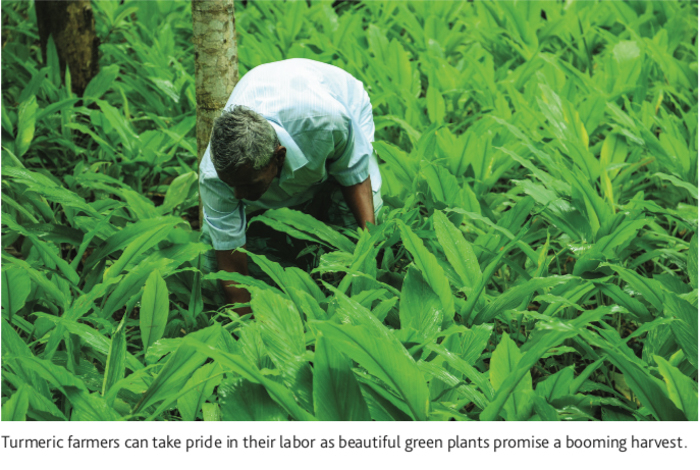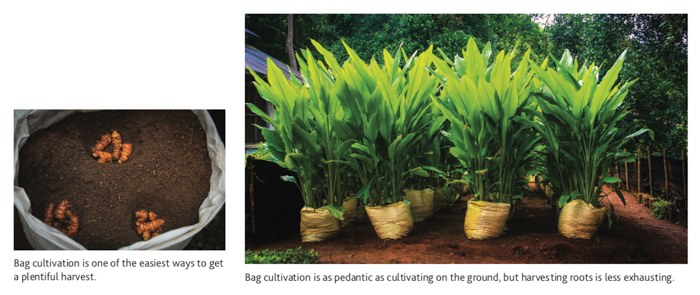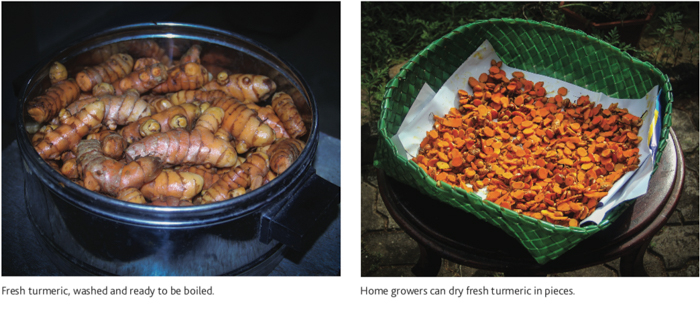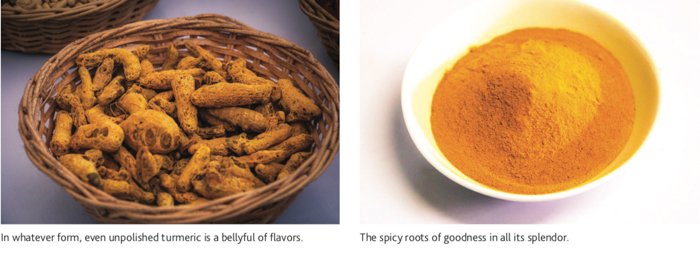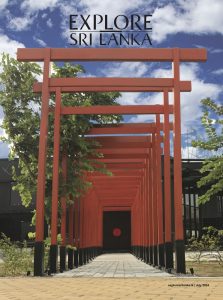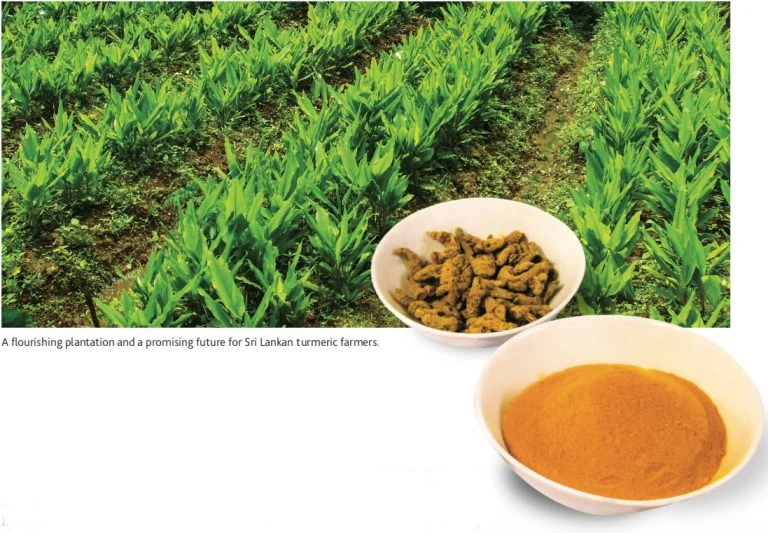
Beautiful as the moon. Golden and brilliant. Holy and auspicious. Healthy and charming. Who wouldn’t be captivated by the energy attributed to turmeric in Sanskrit?
Words Jennifer Paldano Goonewardene.
Dear to the gods and exalted by native physicians, this intense yellow tuber, South Asian in identity, heals, destroys disease causing microbes and en- hances beauty. More importantly, in Sri Lankan cuisine, turmeric is a ‘golden spice’ that is used in every- day cooking. Sprinkling turmeric infused water at the entrance to a home or place of work is a disinfect- ant; and for women, an enhancer of complexion, adds glow and heals skin aberrations. Turmeric is a wonder herb for good health. Since December 2019, the Government, under its agriculture development and import substitution drive to boost local farmers, imposed restrictions on importing turmeric, which has led to a flurry of activity among enthusiastic growers.

For long, Sri Lanka has relied on turmeric imports to fulfil the shortfall of supply from local cultivation. In 2019, turmeric was cultivated in 923 hectares, which produced 9,500 metric tons of fresh turmeric and 1,600 metric tons of dry turmeric. The total annual requirement of the country being 7,500-8,000 metric tons of dry turmeric, Sri Lanka had imported 5,288 metric tons of dry turmeric at a cost of 1,142 million rupees.
By 2023, Sri Lanka hopes to be self- sufficient in turmeric. In the short- term, the State is promoting cultivation and processing, increasing plant production and creating awareness. In the long-term, it hopes to establish a formidable group of farmers and processors, introduce value addition and robustly target the export market, while establishing a turmeric seed garden. In 2021, the Government plans to produce six million turmeric plants, while the initial work for a seed garden is in progress. Sri Lanka is already exporting turmeric; 69.24 metric tons was exported in 2020, which brought in a revenue of 86.30 million rupees.
Sri Lanka is blessed with the perfect climate to grow this perennial herb with yellow to orange, cylindrical and aromatic roots that is cultivable in the wet zone, certain areas in the dry zone and the intermediate zone. Farmers and home growers in Colombo, Gampaha, Kalutara, Galle, Kurunegala, Kandy, Matale, Badulla, Nuwara Eliya, Ratnapura, Polonnaruwa, Monaragala and Ampara, cultivate turmeric in substantial areas of land or in bags. Cultivation begins around March – April. Soil preparation is crucial to a good harvest. Finger roots must be planted at least a meter deep, ensuring that the soil is secure on top; plants must be strengthened with additional soil from time to time to protect the root from exposure to excess light. A layer of mulch, consisting of either saw dust, hay or coconut palm is essential for moisture conservation and weed control, which must be changed every three months. As the roots germinate into plants, fertilizer is applied after 45 and 90 days of planting.

Harvesting takes place during January to March, nine months fol- lowing planting. Detaching the root is meticulous, done gently with a garden fork to avoid damage. Allowing the plant to grow for a specific time period yields good roots, whereas harvesting before maturity will require a higher quantity of fresh turmeric to make one kilogram of dry turmeric. One hectare of turmeric cultivation yields 15-20 metric tons of fresh root. According to local officers, generally, farmers harvest turmeric only upon demand, or else the tubers are left in the soil for at least two-three months in a mixture of sand or coir dust. By May, farmers can choose either to harvest the remaining roots or allow them to sprout into fresh plants. Harvested fresh tubers are stored in a room under low temperatures or in areas where ambient temperature is low.
Equally pedantic is the preparation of fresh turmeric root. Separating the fingers from the mother rhizomes, cleaning begins by soaking in water and scrubbing off the dirt. In separate pots, the mother rhizomes are boiled for about 45 minutes and the finger rhizomes for 30 minutes. If pressure cooked 20 minutes would suffice. The proof of ‘textbook’ processing is when a broken root displays a threadlike substance and the raw odor is absent. The mother rhizomes are cut lengthwise and dried with the finger rhizomes. Under favorable weather conditions, fresh roots have to be sun- dried for at least 10 days. However, on the first five days of the process, strong sunlight between 11 in the morning and 2 in the afternoon is avoided; over exposure to strong sunlight shrivel the roots, which can be prevented by drying them before 11 in the morning and after 2 in the afternoon. Perfect drying ensures quality, and so the first five days are important, the roots can be dried under continuous sunlight for the remaining five days. Machine drying in 55°– 60° Celsius takes a maximum of 18–24 hours.
Dry tubers are harsh in appearance, dull with crusts and root bits. Small- scale farmers follow a very rudimen- tary method of polishing using a tin drilled with small holes; the dry roots are turned in a circular motion inside the tin where the rough surface is scraped against the sharp points of the holes. The same spherical motion is used by large-scale farmers who use a drum shaped machine for smoothening. Polishing by machine adds quality as sprinkling turmeric mixed water on the roots increases shine. Harvested and dried turmeric is stored in sacks lined with polypro- pylene, stacked on wooden frames, away from sunlight, lest it accelerates the process of deterioration. Turmer- ic is processed into powder, slices, fingers, paste and oil.
For domestic use, home growers with limited space are encouraged to grow turmeric plants in bags that give a better yield. A blend of sand, with compost or dung, coir dust and top soil are ideal as the soil is rich in nutrients and ensures moisture conservation. Bag cultiva- tion is encouraged as it’s easy to maintain, simple to harvest and a yield from a bag with a capacity of 50 kilograms is generally 6 kilograms of fresh root. Moreover, home growers can dry the boiled roots in pieces of 2mm thickness until they become crispy, store in airtight con- tainers and when required use a do- mestic blending machine to make turmeric powder.
With tremendous energy being exerted into establishing modern processing facilities and raising quality standards, Sri Lanka’s yellow tubers may soon be dubbed as ‘Ceylon Turmeric’.
Information provided by:
Upali Ranaweera
Director (Development) Department of Export Agriculture Gatambe, Peradeniya.
